the truth behind the moon landings







This and the following pages describe the webmaster's involvement
with the production of The Truth Behind the Moon Landings from
Zig Zag
Productions. The webmaster participated in only one segment of
the program.
While hauling rocks around the set in order to demonstrate certain shadow effects, the webmaster noted some interesting aspects of the lighting provided by the single large 18 kW studio light. These features mimicked some of the lighting effects seen as "anomalous" or "problematic" in Apollo photography. The cart in which the rocks were hauled is a standard piece of grip equipment coincidentally called a "moon buggy" (Fig. 1). It's a bit like a wheel barrow, but fully stable on four wheels. The rocks we carried in it were reasonable facsimiles (in color and texture) of Apollo samples taken from the lunar highlands.
In Fig. 2 the camera looks back along the path of the buggy from the truck in the direction of the light, or "up-sun". The tracks made by the pressurized rubber buggy wheels seem to glow; they are markedly brighter than the surrounding terrain. The same effect can be seen in the Apollo photograph in Fig. 3. The MET has been pulled along with the astronauts, and the astronaut has taken a photo looking back along where they came from. The tracks appear to glow because of a combination of phase effects and texture effects. When the light comes principally from one direction, objects are strongly lit on one side and strongly shaded on the other side. This applies also to elements of a textured surface: the little hills and valleys that make up the texture. If you happen to be looking into the sun (up-sun), you're seeing the shaded sides of the texture elements. The individual elements are too small to see in photographs. But the overall cumulative effect of seeing only the shaded sides of all those tiny texture elements is a dim surface. The same effect doesn't occur if you're looking away from the sun (down-sun) because you're seeing the lighted sides of all the texture elements. If you mash the texture flat -- by rolling over it with a tire, for example -- the effect largely goes away too. And so the now smooth surface presents no shaded sides to the viewer and, in the cumulative effect, appears much brighter. In our reconstruction the tracks don't appear as light because the
dust in the California desert is not as fine as the dust on the moon.
So the moon buggy wheels weren't able to mash it as flat as dust can
be mashed on the moon.
Those texture effects happen on Earth too, especially when the sun is low in the sky. But because of atmospheric diffusion, the difference between light and shade is not as pronounced on Earth as it would be in space, so the effect tends to go unnoticed. But since we had a textured surface and a directional light source, we were able to test the theory. In Fig. 4 a grip is assembling the dolly track that will be used later to shoot videotape. The ground in front of the track shows the original texture of the desert floor mixed in with the texture created by footprints. Note the wood scraps.
In Fig. 5 the same patch of ground (note the wood scraps) is photographed from exactly the opposite direction. In the area near the photographer's head -- where the phase angle is nearly zero -- the desert floor appears textureless and thus uniformly bright. Even though the exposure settings are the same, the ground in Fig. 5 appears brighter in the frame than the ground in Fig. 4. Note also the gradual increase in visible texture toward the bottom of the photo. The phase angle is increasing, allowing the camera to "see over the top" of texture elements to their shadows. Farther in the distance, where the phase angle is close to zero, the objects hide their own shadows.
Here the texture elements are big enough to see. The same is true in other Apollo photographs that are considered problematic.
In Fig. 6 the camera is looking down-sun. The surface appears fairly bright and uniformly smooth. This is because the same thing is happening here as is happening in Fig. 5. The texture is there, but it is invisible because of the small phase angle. Fig. 7 represents the photos considered to be anomalous because they show an apparent fall-off of light on the surface toward the horizon. In other words, conspiracists argue that this must have been taken with artificial light because artificial lights lose intensity the farther you get from them.
This one especially is interesting because of the bright patch just behind Aldrin. As we've learned, the loss of texture gives us an increase in apparent brightness, if we happen to be looking up-sun as we are in Fig. 7. Reconstructing the last moments of Eagle's descent, we discover that this patch of ground was swept by the exhaust from the descent engine a few seconds before touchdown. That erased a lot of the texture and therefore we see the same sort of effect as in the tracks in Figures 2 and 3. The tracks have a sharper edge that makes them more prominent than the soft-edge exhaust effect. But the general darkness of the surface and the falloff toward the horizon have prosaic explanations in the behavior of the texture when lit from a low angle. As seen in our experiment, the ground appears darker when the textures are backlit. Looking up-sun makes the ground darker when the lighting angle is low. The falloff occurs because the general roundedness of the lunar
surface is more pronounced than Earth's. The moon is smaller, and the
horizon is closer. It curves away faster, increasing the phase angle
and thus increasing the texture darkening effect.
Conspiracists get a lot of mileage out of the presumption that reflected light from the lunar surface -- being only about 7% of sunlight -- is not sufficient for fill lighting. Typically they don't do experiments to verify this. And we've yet to see any photometry calculations other than the handwaving reference to albedo. When they do present empirical data, it's only the data that supports their interpretation -- stark shade in a few selected photos that were underexposed. The conspiracists never seem to do any experiments that test their conclusions. So we have to.
In Fig. 8 the photographer placed a rock in the moon buggy and arranged the buggy so that the rock was shaded not only by the back of the buggy, but by its sides so that no light entered either directly from the light source, or indirectly from the desert floor. At normal exposure settings the rock was essentially invisible. In Fig. 9 the camera exposure was augmented to admit more light. Predictably the rock was visible in the photograph, but other portions of the photo -- such as the surface -- were "blown out" and lost a lot of their detail. This is the dilemma photographers face when they use film with narrow exposure latitudes. They must often choose whether to lose detail to shade or lose detail to brightness.
The important thing to understand from these two photographs is the role of exposure in the final appearance of a photo. The ability of the photographer to adjust the camera and affect the apparent brightness of the final image makes casual inspection of a photograph a poor method for determining what the original scene must have looked like to the naked eye, and consequently whether artificial light must have been used. Astute photographic interpreters look for signs like "blown out" detail to determine if a photograph was over- or underexposed, and from there to calibrate the likely visual appearance of the original scene. Conspiracists, on the other hand, blindly assume that the photograph is always a true representation of the brightness and contrast that the naked eye would have seen. Then they try to attribute the different appearances to artificial lights or other nonsense. The photographer here theorized that reflected light from his clothing might be affecting the overall lighting. Fig. 10 is the rock in the buggy photographed from a position where the photographer himself did not contribute to the lighting. The exposure was set to make the rock barely visible.
In Fig. 11 the photographer has moved into a position where the directional light is fully on his clothing, and thus providing fill light to the rock. The exposure settings were the same as in Fig. 10. The results show that if an astronaut is standing in the sunlight photographing a nearby shaded object, his space suit will contribute quite a bit of fill lighting to the overall scene.
The ultimate in suit fill is shown in Fig. 12. The ground at the astronaut-actor's feet is completely shaded from the singular studio light approximately 200 feet (70 meters) away. But the diffuse reflection from the suit creates a pool of illumination at his feet.
|
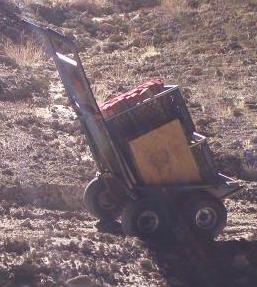
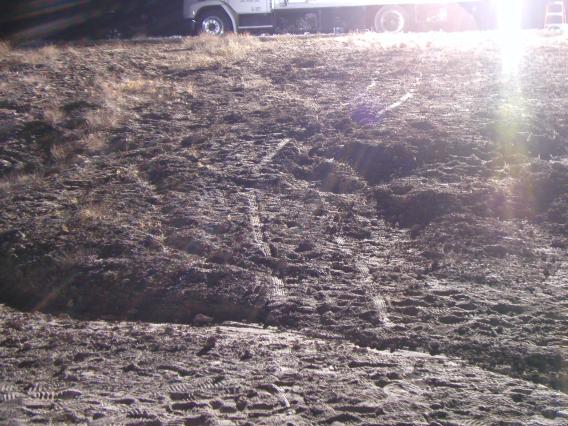
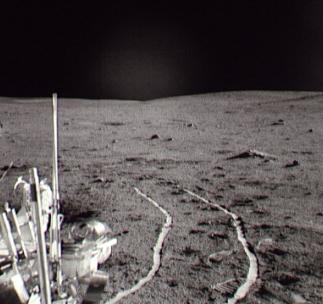
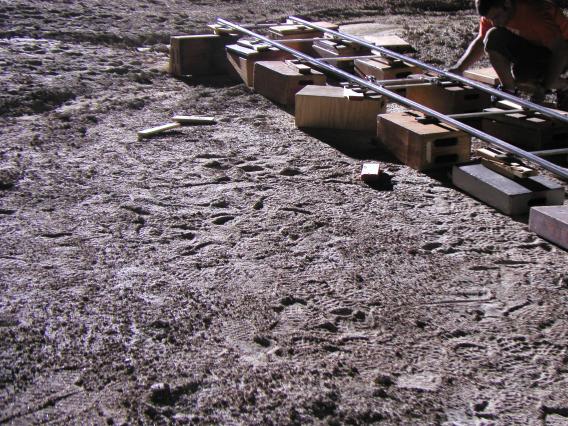
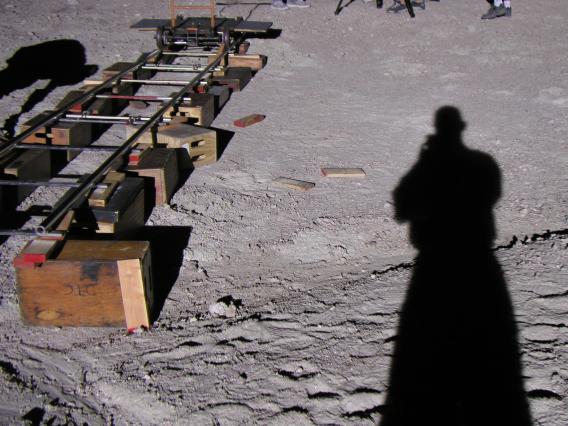
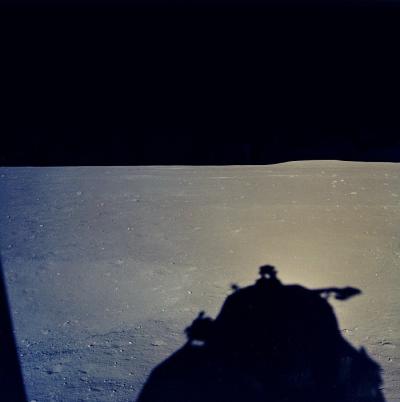
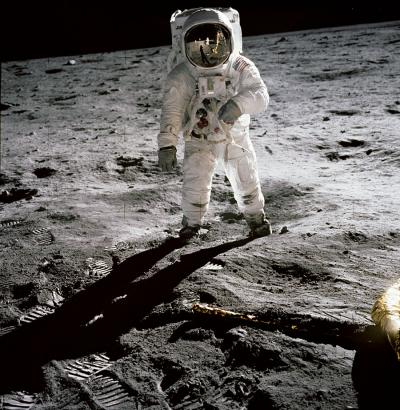
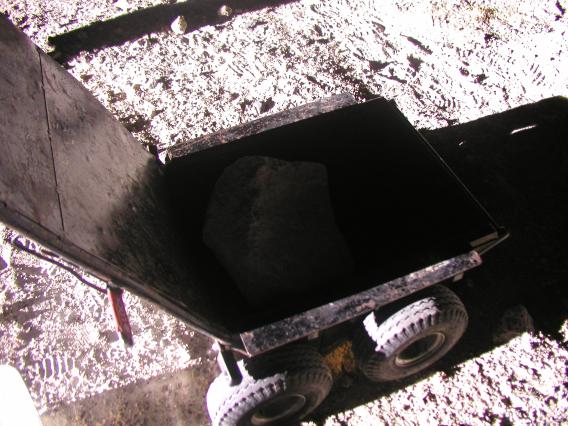
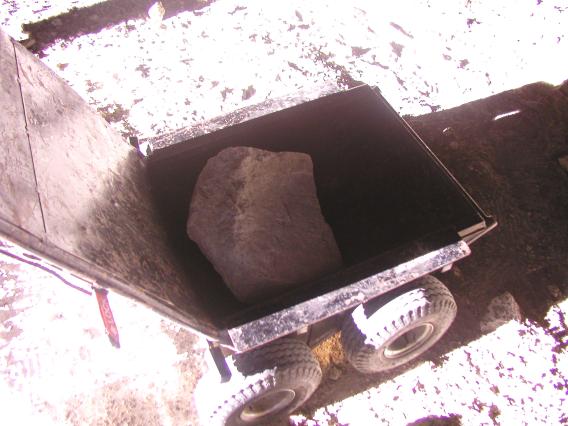
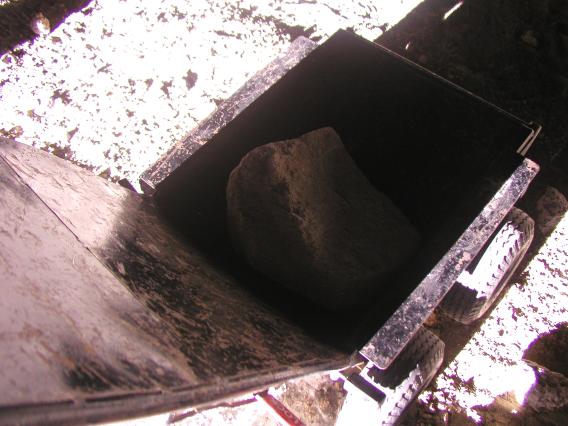
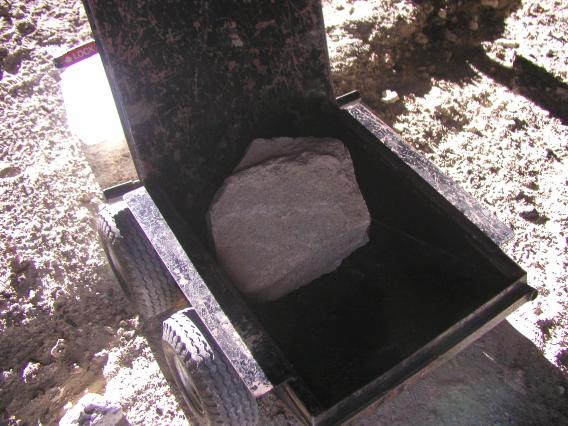
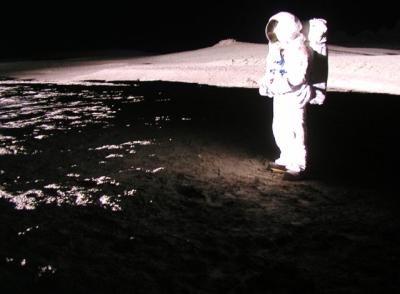
 But you took your
photographs on Earth, in an atmosphere. The reason you can see the
rock in the "moon buggy" is because Earth's atmosphere is diffusing
the light.
But you took your
photographs on Earth, in an atmosphere. The reason you can see the
rock in the "moon buggy" is because Earth's atmosphere is diffusing
the light.
